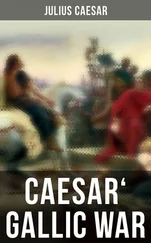Napoleon III - History of Julius Caesar Vol. 2 of 2
Здесь есть возможность читать онлайн «Napoleon III - History of Julius Caesar Vol. 2 of 2» — ознакомительный отрывок электронной книги совершенно бесплатно, а после прочтения отрывка купить полную версию. В некоторых случаях можно слушать аудио, скачать через торрент в формате fb2 и присутствует краткое содержание. Жанр: foreign_antique, foreign_prose, Биографии и Мемуары, на английском языке. Описание произведения, (предисловие) а так же отзывы посетителей доступны на портале библиотеки ЛибКат.
- Название:History of Julius Caesar Vol. 2 of 2
- Автор:
- Жанр:
- Год:неизвестен
- ISBN:нет данных
- Рейтинг книги:4 / 5. Голосов: 1
-
Избранное:Добавить в избранное
- Отзывы:
-
Ваша оценка:
- 80
- 1
- 2
- 3
- 4
- 5
History of Julius Caesar Vol. 2 of 2: краткое содержание, описание и аннотация
Предлагаем к чтению аннотацию, описание, краткое содержание или предисловие (зависит от того, что написал сам автор книги «History of Julius Caesar Vol. 2 of 2»). Если вы не нашли необходимую информацию о книге — напишите в комментариях, мы постараемся отыскать её.
History of Julius Caesar Vol. 2 of 2 — читать онлайн ознакомительный отрывок
Ниже представлен текст книги, разбитый по страницам. Система сохранения места последней прочитанной страницы, позволяет с удобством читать онлайн бесплатно книгу «History of Julius Caesar Vol. 2 of 2», без необходимости каждый раз заново искать на чём Вы остановились. Поставьте закладку, и сможете в любой момент перейти на страницу, на которой закончили чтение.
Интервал:
Закладка:
222
De Bello Gallico , I. 47.
223
It is not unworthy of remark that Cæsar’s communications with the Leuci and the Lingones remained open. We have seen that, in his address to the troops at Besançon, he reckoned on obtaining from these peoples a part of his supplies.
224
Tacitus ( Germania , VI. 32) and Titus Livius (XLIV. 26) speak of this method of fighting employed by the Germans.
225
De Bello Gallico , I. 50. – The predictions of these priestesses, who pretended to know the future by the noise of waters and by the vortexes made by the streams in rivers, forbade their giving battle before the new moon. (Plutarch, Cæsar , 21.)
226
“Having skirmished opposite their retrenchments and the hills on which they were encamped, he exasperated and excited them to such a degree of rage, that they descended and fought desperately.” (Plutarch, Cæsar , 21.)
227
General de Gœler adopts this same field of battle, but he differs from us in placing the Romans with their back to the Rhine. It would be impossible to understand in this case how, after their defeat, the Germans would have been able to fly towards that river, Cæsar cutting off their retreat; or how Ariovistus, reckoning upon the arrival of the Suevi, should have put Cæsar between him and the re-inforcements he expected.
228
As the legions were six in number, the above phrase proves that in this campaign Cæsar had one quæstor and five lieutenants. ( See Appendix D. )
229
Dio Cassius, XXXVIII. 49. – We have adopted the version of Dio Cassius, as we cannot admit with Orosius that an army of more than 100,000 men could have formed only a single phalanx.
230
Dio Cassius, XXXVIII. 49.
231
Orosius expresses himself thus: “United in one phalanx, and their heads protected by their bucklers, they attempted, thus covered, to break the Roman lines; but some Romans, not less agile than bold, rushed upon this sort of tortoise, grappled with the German soldiers body to body, tore from them their shields, with which they were covered as with scales, and stabbed them through the shoulders.” (Orosius, VI. 7.)
232
Dio Cassius, XXXVIII. 49.
233
Appian, De Bello Celt. , IV. 1, 3.
234
The manuscripts followed by the early editors of the “Commentaries” gave some the number of 50 miles, others that of 5 miles. We believe that Cæsar wrote 50 miles. This is proved by the very words he employs, neque prius fugere destiterunt … which could not be applied to a flight of merely a few miles. Moreover, the testimony of old writers confirms the number of 50 miles: Paulus Orosius relates that the carnage extended over a space of 40 miles; Plutarch, over 300 or 400 stadia, that is, 35 or 50 miles, according to the editions; and J. Celsus (Petrarch) ( De Vita J. Cæsaris , I., p. 40, edit. Lemaire) says, usque ad ripam Rheni fuga perpetua fuit , a phrase in which the word perpetua is significative.
Modern writers, supposing erroneously that Cæsar had indicated the distance, that is, the shortest line from the field of battle to the Rhine, have discussed lengthily the number to be adopted. They have overlooked the fact that the Latin text states, not exactly the distance from the field of battle to the Rhine, but the length of the line of retreat from the battle-field to the river. This line may have been oblique towards the Rhine, for it is probable that the retreat of the Germans lay down the valley of the Ill, which they had previously ascended. We must therefore seek towards Rhinau the point where they attempted to re-pass the river.
235
According to Dio Cassius (XXXVIII. 50), Ariovistus, followed by his cavalry, succeeded in escaping. Having reached the right bank, he collected the fugitives; but he died shortly afterwards ( De Bello Gallico , V. 29), perhaps of his wounds.
236
Appian. De Bello Celt. , IV. 1, 3. – Plutarch, Cæsar , 21.
237
De Bello Gallico , I. 53. – The war against Ariovistus became the subject of a poem by P. Terentius Varro Atacinus ( De Bello Sequanico ). (Priscian, X., p. 877, P.)
238
“Inita æstate.” ( De Bello Gallico , II. 2.) — Æstas according to Forcellini, signifies the period comprised between the two equinoxes of spring and autumn.
239
See his biography, Appendix D .
240
Strabo, IV. 171, V. 174.
241
“In the year 642, the consul C. Manlius and the proconsul Q. Cæpio were defeated by the Cimbri and the Teutones, and there perished 80,000 Romans and allies and 40,000 valets ( colones et lixæ ). Of all the army, ten men only escaped.” (Orosius, V. 16.) These data are no doubt exaggerated, for Titus Livius (XXXVI. 38) pretends that Orosius took his information from Valerius of Antium, who habitually magnified his numbers.
242
This route, the most direct from Besançon to the territory of the Remi, is still marked by the numerous vestiges of the Roman road which joined Vesontio with Durocortorum ( Besançon with Rheims ).
243
De Bello Gallico , II. 4.
244
The word fines in Cæsar, always signifies territory. We must therefore understand by extremi fines the part of the territory farthest removed from the centre, and not the extreme frontier, as certain translators have thought. The Aisne crossed the northern part of the country of the Remi, and did not form its boundary. ( See Plate 2. )
245
The retrenchments of this tête-du-pont, especially the side parallel to the Aisne, are still visible at Berry-au-Bac. The gardens of several of the inhabitants are made upon the rampart itself, and the fosse appears at the outside of the village in the form of a cistern. The excavations have displayed distinctly the profile of the fosse.
246
The excavations undertaken in 1862, by bringing to light the fosses of the camp, showed that they were 18 feet wide, with a depth of 9 or 10. ( See Plates 8 and 9. ) If, then, we admit that the platform of earth of the parapet was 10 feet wide, it would have measured 8 feet in height, which, with the palisade of 4 feet, would give the crest of the parapet a command of 22 feet above the bottom of the fosse.
247
The following localities have been suggested for Bibrax: Bièvre , Bruyères , Neufchâtel , Beaurieux , and the mountain called Vieux-Laon . Now that the camp of Cæsar has been discovered on the hill of Mauchamp, there is only room to hesitate between Beaurieux and Vieux-Laon, as they are the only localities among those just mentioned which, as the text requires, are eight miles distant from the Roman camp. But Beaurieux will not suit, for the reason that even if the Aisne had passed, at the time of the Gallic war, at the foot of the heights on which the town is situated, we cannot understand how the re-enforcements sent by Cæsar could have crossed the river and penetrated into the place, which the Belgian army must certainly have invested on all sides. This fact is, on the contrary, easily understood when we apply it to the mountain of Vieux-Laon, which presents towards the south impregnable escarpments. The Belgæ would have surrounded it on all parts except on the south, and it was no doubt by that side that, during the night, Cæsar’s re-enforcements would enter the town.
Читать дальшеИнтервал:
Закладка:
Похожие книги на «History of Julius Caesar Vol. 2 of 2»
Представляем Вашему вниманию похожие книги на «History of Julius Caesar Vol. 2 of 2» списком для выбора. Мы отобрали схожую по названию и смыслу литературу в надежде предоставить читателям больше вариантов отыскать новые, интересные, ещё непрочитанные произведения.
Обсуждение, отзывы о книге «History of Julius Caesar Vol. 2 of 2» и просто собственные мнения читателей. Оставьте ваши комментарии, напишите, что Вы думаете о произведении, его смысле или главных героях. Укажите что конкретно понравилось, а что нет, и почему Вы так считаете.












